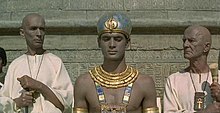Pharaoh (film)
| Pharaoh | |
|---|---|
 Publicity still | |
| Directed by | Jerzy Kawalerowicz |
| Written by |
|
| Starring | |
| Cinematography | Jerzy Wójcik |
| Edited by | Wiesława Otocka |
| Music by | Adam Walaciński |
Release date |
|
Running time | 145 minutes |
| Country | Poland |
| Language | Polish |
| Box office | 7 million tickets[1] |
Pharaoh (
Novel
Kawalerowicz's co-author of the
Film
Pharaoh's production took three years, beginning in the fall of 1962 with the setting up of a studio in
Mass scenes were filmed mainly in
Some scenes were filmed at authentic Egyptian locales. For example, the scene in which Prince Ramses learns that his father Pharaoh Ramses XII has died and that he has now become Pharaoh Ramses XIII, takes place against the backdrop of the
In adapting Bolesław Prus' novel to the screen, the film's producers made a number of notable decisions. One was to keep the film in a predominantly golden-yellowish register and to almost eliminate bright colors; bright foliage appears only once—in the scene with Ramses and Sara on the Nile.[6] During the military maneuvers that open the film, an incident has been introduced that does not appear in the novel, involving the wrangling down of a horse. Near the movie's end, High Priest Mefres is dispatched by the Keepers of the Labyrinth not with a chloroform-like substance, but with a rope looped around his neck and pulled tight by its ends, several yards apart. Pharaoh is among 21 digitally restored classic Polish films chosen for Martin Scorsese Presents: Masterpieces of Polish Cinema.[7]
Plot
The young pharaoh, Ramesses XIII, intends to reform Ancient Egypt. Herhor the priest opposes him. The power struggle between them is the focus of the film.[8] Other themes include the friendship with Pentuer the priest, the love for Sara the beautiful Jewess and Kama the priestess. It is also the story of the secret pact with Assyria, the Solar eclipse and how the priests used it to subdue the crowds, and the assassination of Ramses XIII at the hands of his look-alike. A historical fresco of universal meaning, revealing the mechanisms of power and the influence of religion on social life. [9]
Cast
- Ramses XIII; and his look-alike, Lykon: Jerzy Zelnik
- Herhor (High Priest of Amon): Piotr Pawłowski
- Pentuer (priest, Herhor's assistant): Leszek Herdegen
- Thutmose (Ramses XIII's cousin): Emir Buczacki
- Ennana (Egyptian army officer): Ryszard Ronczewski
- Fellah: Jerzy Block
- Sara (Ramses XIII's mistress, mother of his son Seti): Krystyna Mikołajewska
- Ramses XII (father of Ramses XIII): Andrzej Girtler
- Nitager (Egyptian general): Wiktor Grotowicz
- Queen Nikotris (mother of Ramses XIII): Wiesława Mazurkiewicz
- Berossus (Chaldean priest): Kazimierz Opaliński
- Mefres (Egyptian high priest): Stanisław Milski
- Mentezufis (Egyptian priest): Józef Czerniawski
- Dagon (Phoenician merchant): Edward Rączkowski
- Rabsun (Phoenician merchant): Marian Nosek
- Hiram (Tyrian prince): Alfred Łodziński
- Kama (Phoenician priestess): Barbara Brylska
- Sargon (Assyrian envoy): Jarosław Skulski
- Tehenna (Libyan commander): Leonard Andrzejewski
- Priestess at mummification of Ramses XII: Lucyna Winnicka
- Keeper of the Labyrinth: Bohdan Janiszewski
- Samentu (High Priest of Set): Mieczysław Voit
- Hebron (Ramses XIII's last mistress): Ewa Krzyżewska
- Other principal actors: Bronisław Dardziński, Jerzy Fidler, Jerzy Kozłowski[10]
See also
- List of actors who have played multiple roles in the same film
- List of historical drama films
- List of Polish submissions for the Academy Award for Best Foreign Language Film
- List of submissions to the 39th Academy Awards for Best Foreign Language Film
- National Film School in Łódź
- Pharaoh (the novel)
References
- ^ ISBN 978-1-4766-0803-7.
- ^ "The 39th Academy Awards (1967) Nominees and Winners". oscars.org. Retrieved 2011-11-09.
- ^ "Festival de Cannes: Pharaoh". festival-cannes.com. Retrieved 2009-03-07.
- ^ Martin Scorsese Presents 21 Masterpieces
- ^ Lukaszewicz, A. (January 2017). "Boleslaw prus' "faraon" ("pharaoh")-ancient Egypt and polish context". Pamietnik Literacki. 108 (2): 27–53 – via ResearchGate.
- ^ Leon Schiller State School, "Faraon."
- ^ Martin Scorsese Presents 21 Masterpieces , Scorsese Restores!
- ^ Pharaoh - Jerzy Kawalerowicz
- ^ "Jerzy Kawalerowicz".
- Leon Schiller State School of Film, Television and Theater, "Faraon."
External links
- Pharaoh at IMDb
- Faraon (Polish) Leon Schiller State School of Film, Television and Theater, "Faraon."
